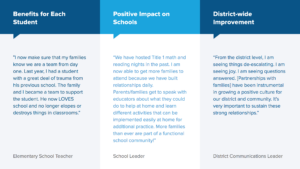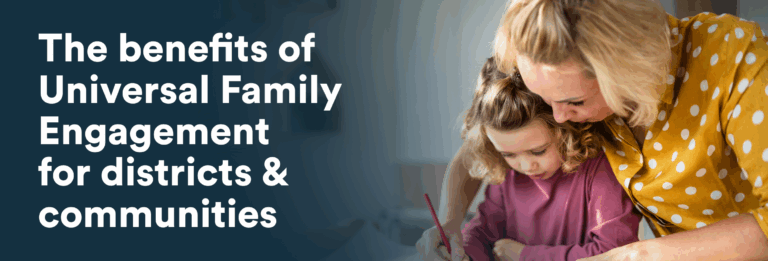Written by Kate Pechacek
A multiplier effect
Universal Family Engagement is the practice of improving outcomes for all students by fostering effective partnerships between schools and families. The research supporting the positive impact of effective family engagement on student outcomes is undeniable. Family partnerships that benefit individual students also benefit classrooms—creating stronger teaching environments, healthier peer dynamics, and deeper school-family alignment.
When family engagement becomes a universal practice, its influence extends well beyond the individual student. Classrooms become more cohesive, inclusive and productive learning environments. The teacher is not left to shoulder the work of educating a child alone—families are partners in the process. As a result, educators report feeling more fulfilled, students experience fewer barriers, and the entire classroom culture shifts for the better.

Research shows the transformative potential of family engagement at multiple levels within the educational system and how, over time, these changes contribute to a more robust district-wide culture and performance. When all families are meaningfully engaged, the classroom as a whole becomes a more connected and effective learning community.
Download our guide to driving student outcomes.
Let’s dive into the benefits at the classroom level:
- Improved teacher retention and satisfaction
When teachers have meaningful partnerships with families, they feel less isolated and more supported. Educators are better able to understand and address student needs and they report higher job satisfaction. Feeling effective and supported reduces burnout, making family engagement a lever for teacher retention. - A more positive and productive classroom culture
Family engagement fosters stronger relationships not only between teacher and family, but also among students. As shared understanding and support increase, so do empathy and collaboration among peers. Classrooms become safer, more respectful, and more productive places to learn. - Deeper trust between schools and families
Purposeful, two-way engagement with families builds lasting trust. When families and educators collaborate consistently and respectfully, they are more likely to problem-solve together. That mutual trust becomes a foundation for strong communication and effective decision-making throughout the school year. These positive relationships have a positive impact on the collective feeling families have about the classroom as a whole. - Barrier identification and removal
When families are engaged, teachers gain a clearer understanding of the challenges that may be affecting student learning, whether academic, emotional or environmental. Instead of guessing, educators and families can work together to identify barriers and remove them, leading to better support for all students. When these barriers are identified across the classroom, it allows a district to better support in efficient and effective ways, particularly for those with shared barriers. It allows a classroom to transition from reactive supports for individual students to proactive and preventative supports. - Practices that support all students
Universal engagement ensures that no student is left behind due to language, culture or family circumstance. When all families are included, classrooms are better equipped to meet the diverse needs of their learners and to distribute resources and support. As a whole, classrooms become more responsive to the experiences and cultures of the collective student group, allowing all students to benefit from the collective group.
At TalkingPoints, we see this every day. Classrooms where Universal Family Engagement is the norm are not only more inclusive—they are more effective. Teachers feel empowered, students are supported and families are true partners in the learning process.
When classrooms thrive, it sets the stage for school-wide and district-wide success. Stay tuned for the next blog in this series as we explore the benefits of Universal Family Engagement at the school level.
See TalkingPoints in action—watch a 90-second explainer video.
Validating some of the benefits for students, TalkingPoints leads to higher academic performance, lower absenteeism, and gap closure in both areas; as shown by rigorous, externally validated causal research.



